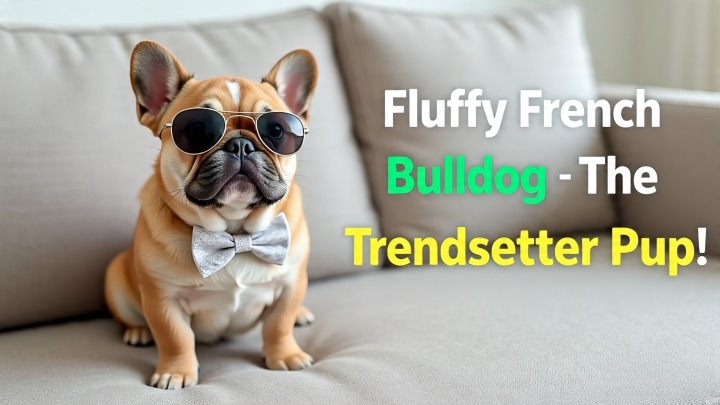“Fluffy French Bulldog lovers, discover everything about this rare long-haired Frenchie – from care and grooming tips to prices, breeders and adoption advice.”
Table of Contents
Introduction
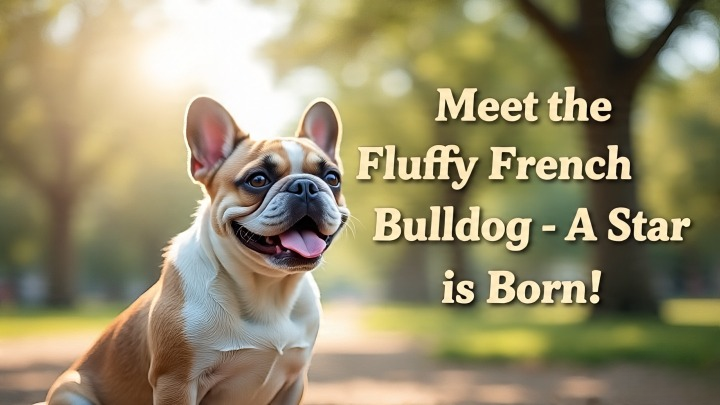
After working as a veterinary surgeon and breed advisor for 15 years, I thought I had experienced every conceivable variation of my favorite breed, the French Bulldog. However, the first time a client entered the office with a fluffy-coated Frenchie puppy, I will admit I did a double take. That moment initiated a deep dive into the genetics and care of these unique dogs, culminating in this article whereby I can share everything I discovered with you. This article will act as a comprehensive guide to the world of the ‘Fluffy Frenchies’ and their beautiful color cousins, revealing fact from fiction, and evidence-based support to aid you in your decision-making.
What Exactly Is A Fluffy French Bulldog?

Let’s start with the star of the show. When someone is searching for a “Fluffy French Bulldog,” they are looking for a dog with a coat that is noticeably longer and softer than the standard French Bulldog’s smooth, shiny, short coat. It is not just a “shaggy” standard Frenchie, it is actually a genetic hair type.
The Genetics Behind the Fluffy Coat

The “long-haired gene” in French Bulldogs explained simply
The key player is the FGF5 gene. Think of genes as recipes. The dominant FGF5 gene provides the recipe for a short coat. The recessive version (l/l) provides an altered recipe that results in a longer anagen (growth) phase of the hair follicle cycle, allowing the hair to grow longer before falling out. For a puppy to be fluffy, both parents must contribute this recessive “longhair recipe.”
How breeders identify carriers of the gene
Responsible breeders use genetic testing from companies like Embark or VetGen. A dog can have three possible genotypes:
- L/L: Homozygous dominant – short coat, cannot produce fluffy offspring.
- L/l: Heterozygous – short coat, but a carrier of the recessive fluffy gene.
- l/l: Homozygous recessive – It displays the fluffy coat phenotype.
By testing breeding stock, breeders can make informed decisions to avoid producing double merles and can plan litters that may include fluffy puppies.
Common myths about fluffy French Bulldogs’ genetics
A pervasive myth is that they are mixed with Pekingese or Chihuahua. Genetic science debunks this; the fluffy coat is a naturally occurring mutation within the purebred French Bulldog population. Another myth is that they are less healthy because of the longhair gene. There is no scientific evidence linking the FGF5 mutation to an increased risk of the breed’s common health issues; the health risks are associated with the breed in general, not the coat length.
History Of The Breed And How The Fluffy Variation Appeared
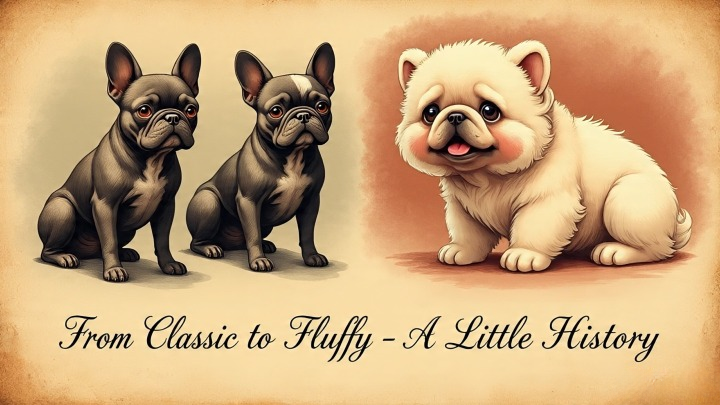
The French Bulldog breed originated from miniature Bulldogs crossing with local ratters in Paris, France, in the 1800’s. The fluffy coat is a spontaneous natural mutation that likely has been in the gene pool for a long time. Breeders in the past were focused on breeding the standard short coat and in doing so would mask the recessive longhair gene. Now, there has been a large interest in uniquely looking dogs, thus breeders have begun to purposely breed carrier dogs to create this additional variety not previously bred for.
Why This Rare Coat Type Is Gaining Attention Online

Social media platforms like Instagram and TikTok are powerful drivers of pet trends. The unusual and endearing appearance of the Fluffy French Bulldog, a deviation from the well-known Frenchie silhouette, generates high engagement through shares and likes. This online virality fuels demand, making them a sought-after status symbol and a topic of fascination among dog enthusiasts worldwide.
Appearance And Unique Traits
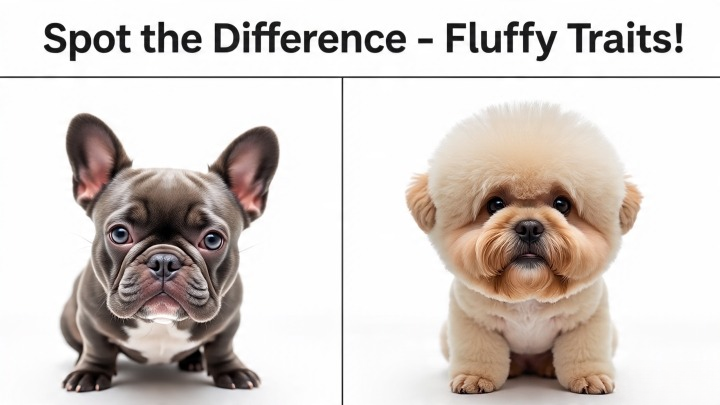
Differences between standard and fluffy French Bulldogs
The most obvious difference is the coat: 1-2 inches long, soft, and often slightly wavy, compared to the short, smooth, glossy standard coat. They have distinct feathering. Their size, body structure, and weight conform to the breed standard; the gene affects only hair length, not bone structure.
Eye color and facial features typical of fluffy Frenchies
Eye color and facial structure are determined by independent genetic components. Their eye color can be any common breed eye color such as dark brown, lighter hazel, or blue (blue eyes are typically associated with the merle pattern, which is a separate gene). The bat ears and brachycephalic (flat) face is exactly the same as the short coated dogs.
Temperament: does the fluff change their personality?
There are no scientific reasons for coat length to affect temperament. A Fluffy French Bulldog’s temperament should adhere to the standard for the breed: playful, alert, adaptable, affectionate, and smart. Temperament is determined by genetics (and their blood line) and more importantly, by environment, training, and socialization.
Lifespan of Fluffy French Bulldogs
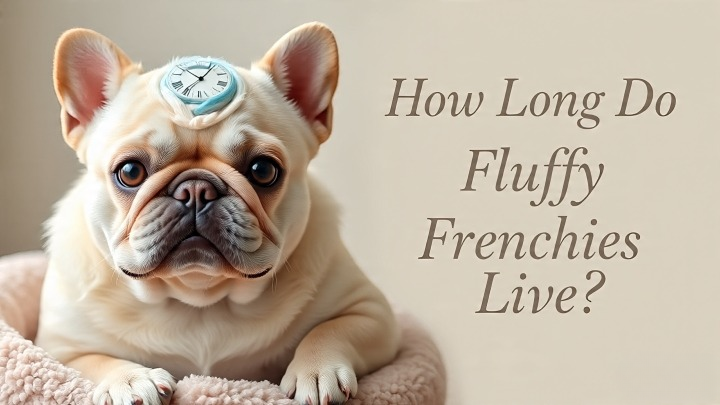
| Fluffy French Bulldog Type / Line | Typical Coat Colour or Trait | Average Lifespan (Years) | Notes on Longevity |
|---|---|---|---|
| Standard Fluffy French Bulldog | Fawn, cream, brindle long-coat | 10–12 | Most common fluffy line; lifespan similar to regular Frenchies |
| Blue Fluffy French Bulldog | Blue or lilac long-coat | 9–11 | May have slightly higher risk of skin issues; good care extends life |
| Merle Fluffy French Bulldog | Merle pattern long-coat | 9–11 | Extra attention to eye/ear health can help longevity |
| Chocolate Fluffy French Bulldog | Chocolate or cocoa long-coat | 10–12 | Balanced diet helps maintain healthy weight |
| Isabella Fluffy French Bulldog | Rare pale lilac long-coat | 9–11 | Usually more expensive; same general lifespan |
| Fluffy French Bulldog Mixed Lines | Mixed coat colours long-coat | 10–13 | Well-bred mixes can sometimes be a bit sturdier |
Lifestyle, diet, exercise, and responsible breeding have a bigger impact on a fluffy French Bulldog’s lifespan than its colour or line. Good vet care can push them toward the upper end of these ranges.
Beyond the Fluff: A Spectrum of Stunning Colors

The world of French Bulldogs consists of a rainbow of colors, each with its own genetic makeup. While the fluffy gene pertains to the length of the coat, other genes are responsible for color and pattern. Let’s review some of the most popular variants you may own.
The Blue French Bulldog
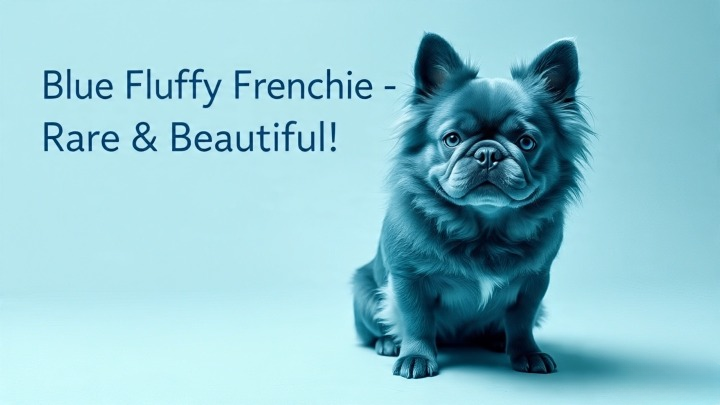
One of the most popular dilute colors is the blue Frenchie. A French Bulldog identified as “blue” is not a sky blue; it is a sound grayish-blue or steely color that can be as light or dark. This beautiful color comes from a dilute gene acting on a black coat. In other words, the dilute gene causes the granules of pigment to clump unevenly instead of producing black pigment (eumelanin), promoting more light to come through, and giving it a blue look.
Important Health Note: The gene associated with the blue color (d/d) is associated with a higher likelihood of Color Dilution Alopecia (CDA), which is a skin condition where the dog is prone to hair loss, patchy alopecia, and sensitive skin that can become infected. Not every blue Frenchie (French Bulldog) will develop CDA, but the incidence is still significant. As a veterinarian, I urge that individuals who are considering the acquisition of a blue Frenchie be extra vigilant with skin care and work with a veterinarian who is familiar with the condition.
The Lilac French Bulldog
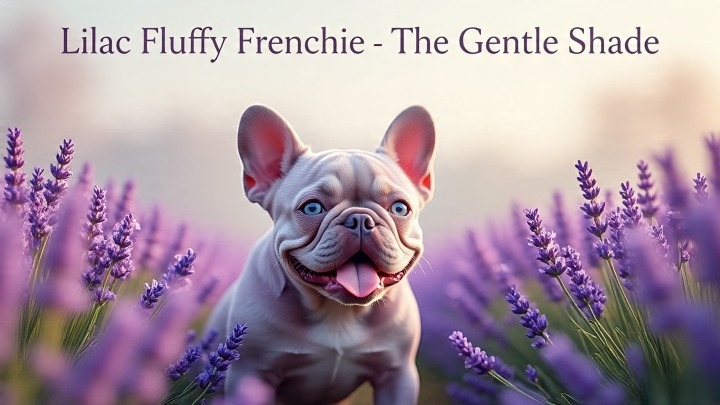
If the blue Frenchie is rare, the lilac is its even rarer cousin. A lilac French Bulldog is a lighter, more lavender-brown variety of the blue. This color is the result of a double diluted dog: the puppy receives the blue dilute gene (d/d) and the chocolate gene (b/b). The black pigment has been altered into the distinct, pale lilac shade. Typically, the lilac color combination may also have light or pale-colored eyes that can be amber, blue or jade.
Like the blue, lilac Frenchies are also at risk for Color Dilution Alopecia. Their unique and striking appearance comes with a responsibility for dedicated skin and coat maintenance.
The Long Haired French Bulldog
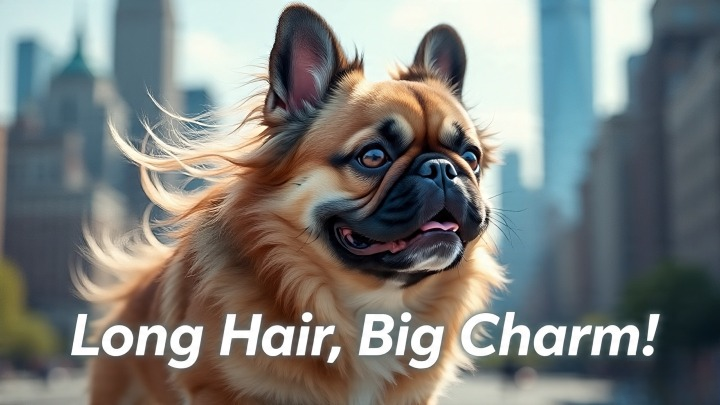
In short, this is simply another name for the Fluffy French Bulldog. The term “long-haired” can be somewhat misleading only because their hair is not as long as Yorkshire Terrier hair. Their hair is around 1-2 inches long, soft to the touch, and is typically a little wavy. These Frenchies would also have noticeably feathering, or slightly longer hair on their ears, chest, legs, and tail. The grooming of a long-haired Frenchie is essentially the same as a regular Frenchie, the only difference is you may need to brush a little more frequently to avoid matting and to remove hair that has fallen out.
The Mini French Bulldog

This is a term that requires extreme caution. A “mini” or “teacup” French Bulldog is not a recognized or standard size variation. There are only two ways breeders produce significantly smaller Frenchies:
- Runts: Consistently breeding the smallest runts of multiple litters, which can perpetuate health weaknesses.
- Dwarfism: Introducing other dwarfism genes, which can lead to severe skeletal problems.
- Crossbreeding: Mixing Frenchies with smaller breeds, resulting in a dog that is not a purebred French Bulldog.
As a vet, I strongly advise against seeking out a “mini” Frenchie. The health problems, including brittle bones, organ problems, and neurological issues, can cause heartbreak and significant bills for veterinary services. A healthy, well-bred standard-sized Frenchie is always the best option.
The Black French Bulldog
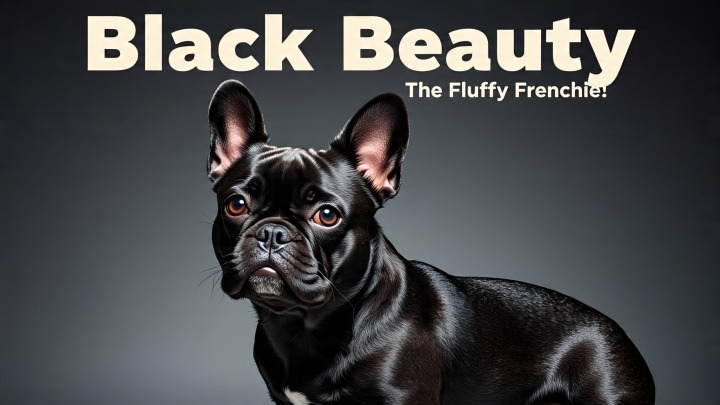
A solid black French Bulldog is a classic and beautiful sight. They should have a uniform black coat with no brindling, sometimes with small white markings on the chest. The black coat is governed by a dominant gene, making it one of the more common and genetically stable colors. From a health perspective, black Frenchies do not carry the dilute gene and are therefore not at risk for Color Dilution Alopecia, making them a robust choice in terms of coat health.
The Blue Merle French Bulldog
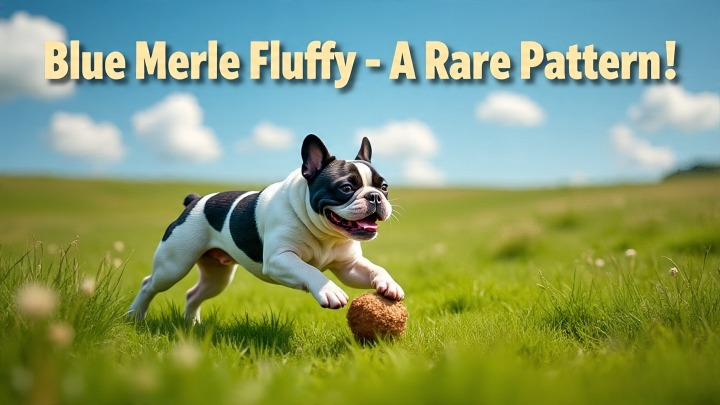
The merle pattern creates a mottled, patchy effect of dark and light areas. A blue merle Frenchie has a gray base with patches of darker gray and black. This pattern is undeniably striking. However, it is arguably the most controversial color in the Frenchie world due to significant health risks.
The merle gene (M) is not originally part of the French Bulldog breed and was most likely introduced through outcrossing generations ago. The primary concern is breeding two merle dogs (M/m x M/m) results in a 25% chance to produce a double merle (M/M) puppy. These puppy’s chance of being born blind, deaf, or have some severe eye abnormalities, is extremely high.
French Bulldog Variations At A Glance
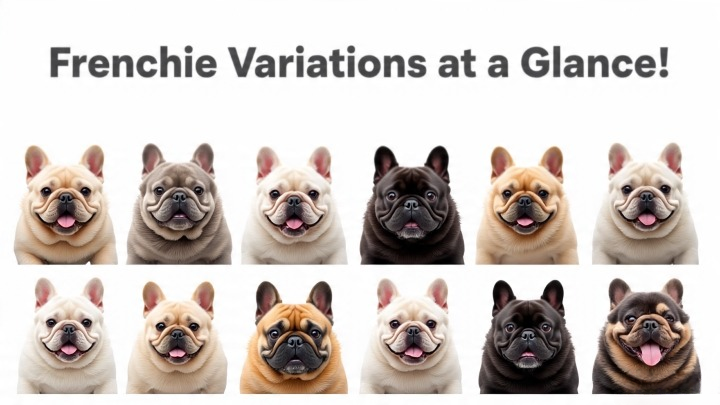
| Variation | Primary Genetic Cause | Key Consideration |
|---|---|---|
| Fluffy/Long Haired | Recessive longhair gene (l/l) | Rare, natural mutation. Requires slight extra grooming. |
| Blue | Dilute gene on black coat (d/d) | High risk for Color Dilution Alopecia (CDA). |
| Lilac | Double dilute (d/d + b/b) | Highest risk for CDA. Very rare color. |
| Mini | Non-standard breeding practices | Not recommended. High risk for severe health issues. |
| Black | Dominant black pigment (K-locus) | Common, stable, and no extra health risks associated with color. |
| Blue Merle | Merle pattern gene (M) | Purchase with extreme caution. Risk of blindness/deafness, especially in double merles. |
Caring For Your Fluffy French Bulldog: A Vet’s Advice
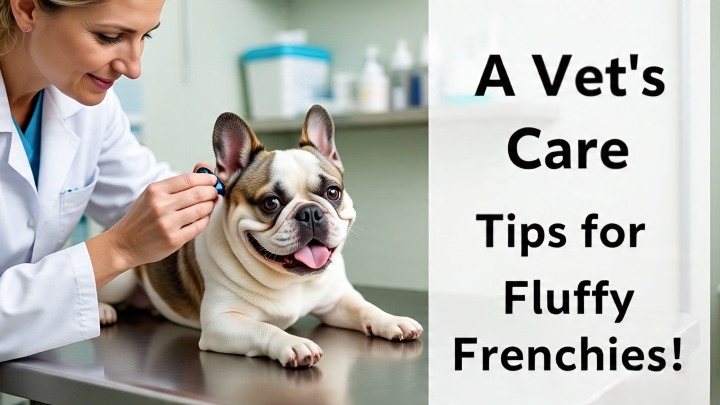
How to brush and detangle their longer coat
To avoid matting, brush your dog’s whole coat with a slicker or soft pin brush 2-3 times each week to remove excess coat and eliminate mats. Be sure to work through areas of friction, such as behind the ears or under the legs, and about the collar. You may also choose to apply a detangling spray to allow you to work out knots without breaking the coat.
Bathing tips to keep the coat healthy and shiny
Bath every 4-6 weeks if necessary; always use a high-quality, oatmeal or hypoallergenic shampoo and a conditioner meant for dogs. A conditioner is a must to retain moisture to avoid dryness and to manage the coat of longer hair. Rinse thoroughly and ensure to dry completely, especially in skin folds, to avoid bacteria or yeast infections.
Seasonal shedding and how to manage it at home
While no French Bulldog is fully hypoallergenic, the fluffy Frenchie may appear to shed less because the longer hair gets caught in the top coat instead of quickly falling out. Frenchies do shed, and all Frenchies will require maintenance brushing (especially with the seasonal changes in the spring and fall). As you are brushing the Frenchie, you will be able to trap the loose hairs in your brush, which will significantly lessen how much hair makes its way to your clothing and furniture.
Health Considerations

Are fluffy French Bulldogs more prone to health issues?
The longhair gene itself is not associated with any specific disease. But they are purebred French Bulldogs and so are prone to all the common breed health problems. Their health profile is identical to that of a standard Frenchie; the “fluff” does not confer any health advantages or additional risks related to brachycephalic syndrome, joints, or spine.
Common conditions to watch for
Key breed-related issues include:
- Brachycephalic Obstructive Airway Syndrome (BOAS): Difficulty breathing due to shortened airways.
- Allergies: Both environmental and food allergies, which often manifest as skin issues.
- Intervertebral Disc Disease (IVDD): Spinal issues due to their chondrodystrophic (shortened) structure.
- Hip Dysplasia: A malformation of the hip joint.
- Patellar Luxation: Dislocating kneecaps.
Diet And Exercise Needs

Feeding for healthy skin and coat
A high-quality diet that is rich in healthy fats, including omega-3 and omega-6 fatty acids, is necessary for optimal skin health and a healthy coat. Foods containing fish oil, salmon, or, and a source of omega-3 or omega-6 fatty acids should be selected. If a dog has allergies, it may be beneficial to seek a novel protein diet, such as duck or kangaroo protein (or a hydrolyzed protein diet) under veterinary guidance.
Recommended exercise routines
Due to BOAS, exercise must be moderated. It is best to take short, casual walks that are typically 10-15 minutes long during moderate temperatures. Do not exert yourself, or take walks during the heat of the day or when it is too humid. You should always look out for signs of overheating; too much panting, having a labored breath, bright red or purple gums, or stumbling.
Indoor vs outdoor play
Indoor play in a climate-controlled environment is safest. Puzzle toys, short sessions of fetch in a hallway, and training games provide excellent mental and physical stimulation without the risks associated with outdoor heat or overexertion. Always provide constant access to fresh, cool water.
Expected Price Range And Why They’re More Expensive

Due to their rarity and high demand, Fluffy French Bulldogs are significantly more expensive than standard ones. Prices typically range from $10,000 to $30,000+, depending on color, pedigree, and the breeder’s reputation. The high cost reflects the breeder’s investment in extensive health testing, genetic screening, and the fact that only a portion of a litter will inherit the two recessive genes and display the fluffy phenotype.
The base price for a standard-colored Fluffy French Bulldog (e.g., brindle, fawn, pied) is already high due to the rarity of the recessive longhair gene. The price increases from there based on the rarity and complexity of the color genetics involved.
| Variety | Price Range (USD) | Key Factors Influencing Cost |
|---|---|---|
| Standard Color Fluffy (Fawn, Brindle, Pied, White) | $12,000 – $20,000 | This is the baseline. Price is driven by the rarity of the fluffy coat itself, the health testing of the parents, the breeder’s reputation, and the puppy’s conformation to breed standards (aside from coat). |
| Black Fluffy | $15,000 – $23,000 | A solid black coat is a dominant and less common color. The price is higher than standard colors due to its striking appearance and relative scarcity in well-bred lines. |
| Blue Fluffy (Isabella) | $18,000 – $28,000 | The blue dilute (d/d) gene is recessive and rare. The significant price jump accounts for the specialized genetic testing required and the high demand for this popular color. Note: This color is linked to a higher risk of Color Dilution Alopecia. |
| Lilac Fluffy (Isabella) | $20,000 – $30,000+ | The lilac coat requires a dog to inherit both the blue (d/d) and chocolate (b/b) recessive genes (a “double dilute”). This is a very rare genetic combination, commanding a premium price. |
| Chocolate Fluffy | $17,000 – $25,000 | The chocolate (b/b) gene is recessive. Like the blue, its rarity and the specific breeding required to produce it increase the cost. Often has light hazel or green eyes. |
| Blue Merle Fluffy | $25,000 – $40,000+ | Extreme caution is advised. The merle pattern (M/) is not native to the breed and is complex. The extremely high price reflects intense market demand. Ethical breeders will price merle puppies with all health clearances at the top end of this range. Unethical breeders may charge less but will not health test, greatly increasing the risk of blind, deaf, or otherwise unhealthy puppies. |
| Fluffy Merlequin (Merle with White) | $30,000 – $50,000+ | The rarest and most expensive combination. This price is for a fluffy Frenchie that is both merle and has significant white patterning (piebald). The genetics to produce this are incredibly complex and rare in ethically bred lines. |
Important Notes On What These Prices SHOULD Include

An ethical breeder’s high price is an investment in your puppy’s health and well-being. This cost should encompass:
- Comprehensive Health Testing of Parents: This is non-negotiable. This includes tests for hips (OFA/PennHIP), spine, patellas, heart, eyes, and genetic panels for conditions like DM and HUU.
- Specialized Care: Whelping and raising a Frenchie litter is expensive. They often require artificial insemination and C-sections for delivery, plus round-the-clock neonatal care.
- Early Puppy Socialization: Reputable breeders invest in “Early Neurological Stimulation” (ENS), puppy culture programs, and proper socialization, which is critical for a stable temperament.
- Initial Veterinary Care: The price should include first vaccinations, deworming, a microchip, and a thorough vet check before the puppy goes home.
- Health Guarantee: A contract that protects you from unforeseen genetic health issues is a hallmark of a reputable breeder.
Warning: If you see a Fluffy French Bulldog advertised for significantly less than these ranges, it is a major red flag. The lower cost almost always means the breeder has cut corners on health testing, which will likely cost you tens of thousands of dollars in veterinary expenses later and result in heartbreak.
A Success Story: Winston the Fluffy Frenchie

I want to tell you about one of my favorite patients, Winston. Her owner, Sami, did her homework to find a good breeder that tested both parents (who were short-coat carriers). When Sami got her puppy Winston home, she was committed to the его welfare. She regularly brushes him, keeps him at an appropriate weight, and they take nice short ,slow walks in the cool evening temperatures. At his last vet visit, Winston was a lovely healthy four years old and was a wonderful example of how responsible dog ownership and a good genetic start will provide a nice life for a Fluffy French Bulldog.
Choosing An Ethical Breeder: Your Most Important Step

This is the most critical part of your journey. The popularity of rare colors and coats has unfortunately led to a rise in irresponsible breeding.
A reputable breeder will:
- Health Test: They will provide OFA (Orthopedic Foundation for Animals) or PennHIP certifications for hips, patella evaluations, and cardiac exams. They will also test for common genetic disorders like juvenile cataracts and degenerative myelopathy.
- Be Transparent: They will openly discuss the health risks associated with specific colors like blue or merle. They will happily show you where the dogs live and introduce you to the puppy’s parents.
- Be Knowledgeable: They can explain the genetics behind the fluffy coat or the lilac color without hesitation.
- Ask You Questions: They will interview you to ensure their puppy is going to the right home.
Walk away immediately from any breeder who:
- Focuses solely on rare colors and high prices.
- Has multiple litters available at all times.
- Cannot provide health clearances.
- Pressures you to buy.
Conclusion: A Unique Friend With Unique Needs

The Fluffy French Bulldog and its blue, lilac, and merle counterparts are a fascinating study in canine genetics, and they are undeniably appealing and loving pets. However, their special traits and features necessitate increased awareness and responsibility on the part of would-be parents.
Your objective is not simply to uncover the most unique hue or the fluffiest coat but to discover the most adaptable, healthy, happy puppy. When you place health over looks and choose an ethical breeder, you aren’t merely buying a puppy; you are investing in a long impending happiness and overall healthy life with your new buddy. It requires work, preferable to get dog owners on your side, do your research, ask the tough questions, and your reward will be more than balanced on how amazing your puppy looks.
FAQs
-
What is a Fluffy French Bulldog?
A Fluffy French Bulldog is a purebred French Bulldog that possesses a recessive gene (the Fibroblast Growth Factor 5 or FGF5 gene) which gives it a longer, softer coat than the standard short-haired Frenchie. It is not a mixed breed.
-
Are Fluffy French Bulldogs hypoallergenic?
No, a Fluffy French Bulldog is not hypoallergenic. While their longer hair may trap shed dander closer to the skin temporarily, they still produce the allergens (found in their dander and saliva) that affect people with allergies.
-
How much does a Fluffy French Bulldog cost?
The price of a Fluffy French Bulldog is significantly higher than a standard Frenchie due to its rarity, typically ranging from $12,000 to over $30,000. The final cost depends on color, the breeder’s reputation, and most importantly, the extent of health testing performed on the parents.
-
Is the Fluffy French Bulldog recognized by kennel clubs?
No, major kennel clubs like the American Kennel Club (AKC) and The Kennel Club (UK) currently recognize only the standard short coat in their breed standards. Therefore, a Fluffy French Bulldog cannot be shown in conformation events.
-
Do Fluffy French Bulldogs have more health problems?
The longhair gene itself does not cause additional health issues. However, a Fluffy French Bulldog is still prone to all the common health problems of the breed, such as Brachycephalic Syndrome, allergies, and joint issues. Reputable health testing of the parents is critical.
-
How do you groom a Fluffy French Bulldog?
Grooming a Fluffy French Bulldog requires brushing 2-3 times a week with a pin brush to prevent mats and remove loose hair. They need regular bathing and must be dried thoroughly, especially in their skin folds, to prevent infections.
-
What is the temperament of a Fluffy French Bulldog like?
The temperament of a Fluffy French Bulldog is identical to the standard breed: affectionate, playful, adaptable, and intelligent. Coat length is determined by a single gene and does not influence personality, which is shaped by genetics and upbringing.
-
How is a Fluffy French Bulldog bred?
A Fluffy French Bulldog is produced when both parents carry and pass on the recessive longhair gene (l/l). This can happen even if both parents have standard short coats, as long as they are both carriers (L/l) of the gene.
-
What is the rarest color for a Fluffy French Bulldog?
One of the rarest colors is the Fluffy French Bulldog in a lilac or Isabella shade. This requires a puppy to inherit the recessive longhair gene plus two sets of dilute genes (blue and chocolate), making it a complex and uncommon genetic combination.
-
Where can I find a reputable breeder for a Fluffy French Bulldog?
To find a reputable breeder for a Fluffy French Bulldog, look for one who prioritizes health testing (OFA, cardiac exams), is transparent about genetics, allows you to meet the parents, and has a contract with a health guarantee. Avoid breeders who focus solely on rare colors and high prices.
